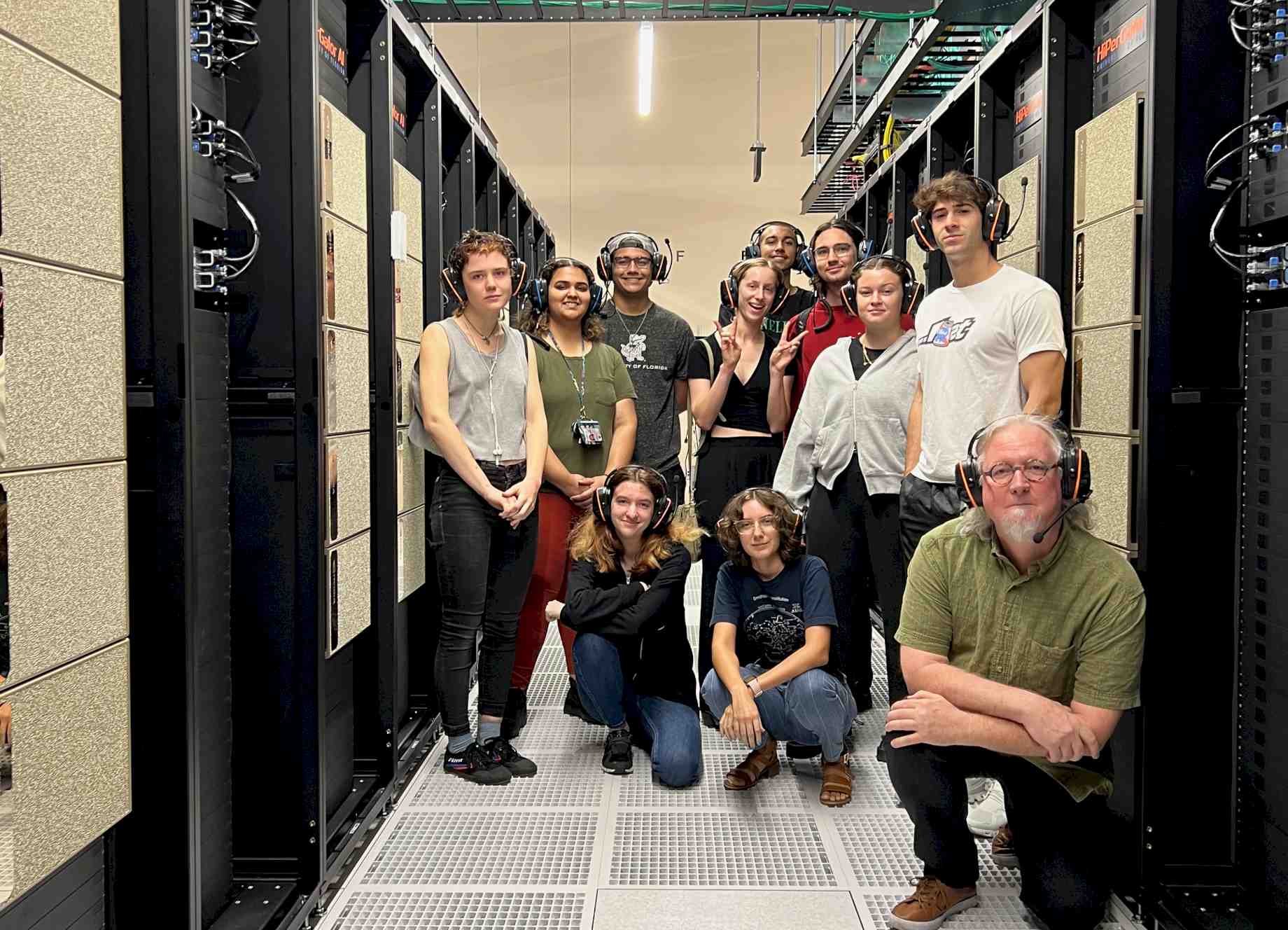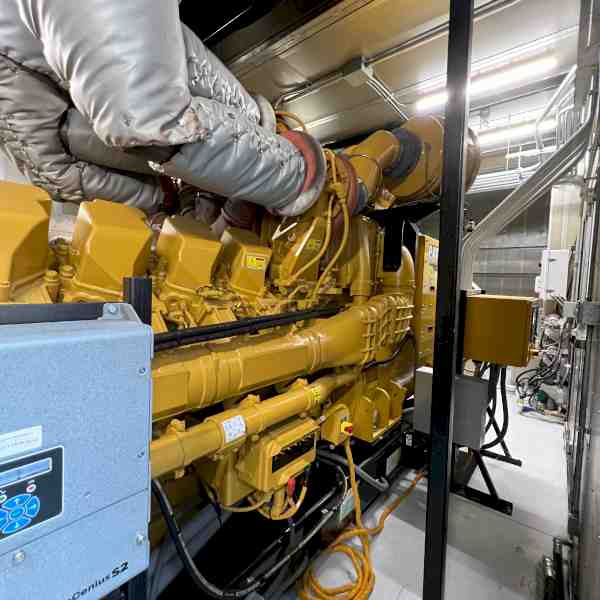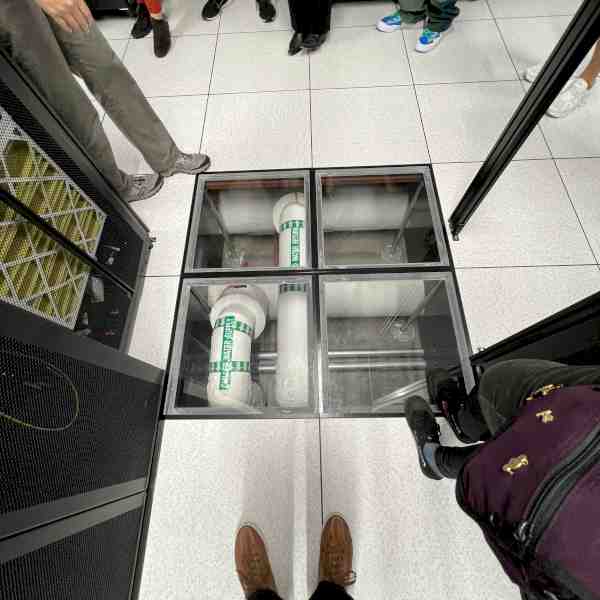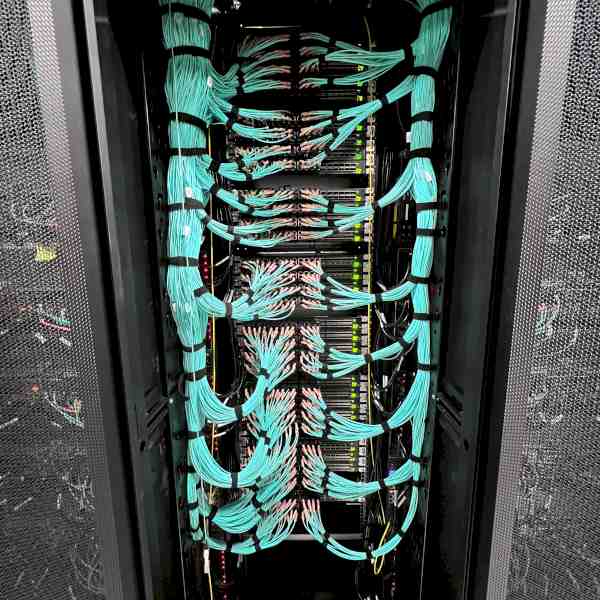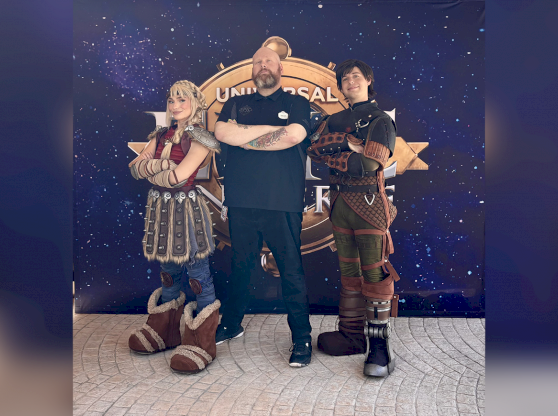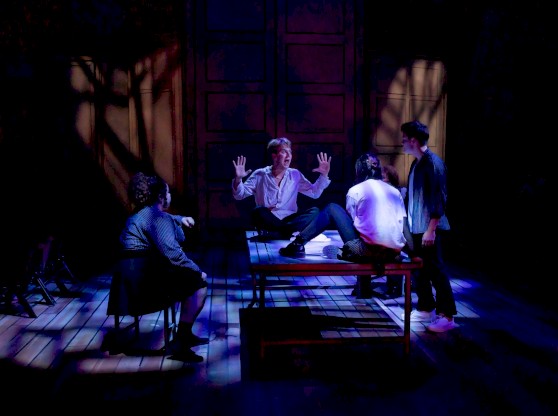The curiosity and conversation buzzing through the University of Florida about artificial intelligence (AI) should come as no surprise: #AIatUF is a big deal.
In launching the university-wide AI Initiative in 2021 and facilitating faculty, student, and cross-affiliated researchers’ access to UF’s NVIDIA-powered supercomputer, HiPerGator 3.0, the university has become the central hub for AI research and innovation in the state of Florida.
And beyond UF, from major hospitals and mega concert stages to small rural clinics, and right down to the music streaming into your living room speakers: AI is showing up everywhere.
Technological advancements often develop contemporaneously with anxieties regarding their impact on cultures, on job sectors; on humanity, itself. And throughout history: artists have helped societies understand and reckon with new technologies as they emerge; even innovated entirely new ways to experience and interact with them.
Multidisciplinary artist and associate professor of AI and the Arts: Art and Global Equity, Fatimah Tuggar, explains:
"Arts and technology have parallel histories, each helping the other to progress. Early writing was pictorial and evolved to script. Initially, lens-based media was questioned as not being ‘art’ in the field of photography. The mechanical age of reproduction changed visual art with mass-produced objects, starting with Duchamp's ‘Bicycle Wheel,’ among other ready-mades. Harold Cohen, in 1973, created an AI learning machine he taught to paint called ‘AARON.’ History allows us to know who we are and where we have been, to learn from the past—and it helps us innovate for the future. The role of the artist is to question the status quo. For my students and for myself: I want us to be imaginative, adaptive, provocative—a culture jammer or resistor, if necessary," Tuggar says.
In a moment when AI and its digital companions—virtual reality (VR), augmented reality (AR), and blockchain technology—are undergoing exponential cross-sector implementation and growth: the arts offer a crucial lens to observe, critique, and imagine their potentialities.
In 2021, the UF College of the Arts (COTA) welcomed an 'AI and the Arts' faculty cohort to lead arts research and instruction around artificial intelligence, AR/VR, and blockchain technologies. The COTA AI and the Arts cohort applies curricula that responds in real-time to the emerging potential, complexities, and challenges of AI, and its impacts on humanity.
Addressing the AI-generated elephant in the room: is it art?
News headlines and social media discourse buzzing around the rapidly evolving roles of AI are cropping up daily in 2022. In the arts sector, the query of “is it art?” looms particularly heavy around the use of artificial intelligence. But while the technology sparking the controversy may be new, the question is not.
When a digital "painting” created using the text-to-AI artmaking tool, Midjourney, appeared at the Colorado State Fair this August and took home first-place in the category of “emerging digital artists,” a headline on the tech news site, Vice Motherboard, announced: An AI-Generated Artwork Won First Place at a State Fair Fine Arts Competition, and Artists Are Pissed.
And—rightfully so? Video game designer, Jason M. Allen, who generated the AI prompts behind the prize-winning artwork, told the New York Times, “Art is dead, dude ... It’s over. Humans lost.”
But Amelia Winger-Bearskin, Banks Preeminence Chair and associate professor of AI and the Arts: Digital Arts and Sciences in UF COTA’s Digital Worlds Institute, has a less cynical take.
In her essay, Is AI Art Real Art?, Winger-Bearskin, like Tuggar, references the philosophical fracas that was stirred by Dada artist, Marcel Duchamp, and his ready-made ‘Bicycle Wheel’ in 1913:
“He forced new ways of looking at the objects that are all around us—shovels, math textbooks, bicycle wheels, chimney ventilators … In the early part of the twentieth century, many of these prefabricated items were new enough to feel unfamiliar and strange. At the same time, they were quickly becoming so ubiquitous as to be all but invisible. Duchamp’s ready-made pieces brought these objects to view in a new way and caused audiences to ask new questions.”
The heavyweight of those questions—is it even art?—sits at the heart of conversations around AI today. In the case of the Colorado State Fair award-winning, AI-generated digital painting, ‘Théâtre D’opéra Spatial’ (French for ‘Space Opera Theater’): the artist may not have touched a Photoshop digital paintbrush—but Allen says he did put roughly 80 hours of work into creating the artwork using Midjourney, nonetheless.
In 2019, the American Scientist magazine asserted that AI Is Blurring the Definition of Artist. Last year, a Forbes headline addressed the century old, Duchampian ready-made question—but tailored for the digital age: Is Artificial Intelligence Set To Take Over The Art Industry?
The philosophical quandaries being posed in real-time by artworks like ‘Théâtre D’opéra Spatial’ generate frequent, anxiety-stoking headlines like the one in Forbes. But to Winger-Bearskin, the answer is clear: AI need not portend doom for the arts, nor, more broadly, for humanity. She asserts that AI can be a tool for good—depending on how humans choose to wield it.
“The consensus seems to be: we should not restrict the definition of art; we should expand it. Art doesn’t even need to have a physical form—it can be completely immaterial. What matters is the decisions the artist makes, how the public interacts with it, and what it means to the community and culture from which it springs,” Winger-Bearskin writes.
Winger-Bearskin's Talk To Me About Water project and her AI Climate Justice Lab are just two examples of how artists are wielding AI as a tool for good—in these instances: by leveraging digital data curation, Indigenous knowledge and storytelling techniques, and visualization strategies developed by creative technologists to make complex environmental and climate science topics more legible to broad, lay audiences.
Artists with digital tech and AI skills are in high cross-sector demand
Jack Stenner, PhD, associate professor of Art + Technology in the School of Art + Art History (SAAH) teaches experimental cinema and digital art and animation. He also leads Experiments in ARTificial Intelligence, a digital workshop Stenner designed as an access point for artists to get hands-on experience working with AI. His students were among the first at COTA to utilize HiPerGator last year.
Stenner can easily list more than a dozen career paths where Art + Tech students find success: studio art, multimedia communications, UI/UX, cinematography and film production, museum and gallery design and installation, animation, and video game design, to name a few.
And: “over the next decade, the U.S. Bureau of Labor Statistics predicts studio practices like ours will be the fastest-growing arts and design employment sector," Stenner notes.
But while he acknowledges the pragmatic value of technical skill acquisition, Stenner emphasizes that nurturing a spirit of curious, artistic experimentation is central to his teaching philosophy.
"As a first-generation college graduate who has experienced multiple career changes throughout my life, I am very aware that we have to prepare and remain flexible in the face of uncertainty. The specific technical aspects of my undergraduate education were infinitely less important than my training to be a creative thinker, lifelong learner, and maker who can adapt to change," Stenner says.
"So, from my point of view: we're not training students for AI careers. We don't even know what those might be, or for how long. Instead, we are teaching students how to work in a world that includes AI. Its impacts will grow exponentially; therefore, it is incumbent on education to prepare citizens for this eventuality.
"But the goal," Stenner says, "is to teach art students how to make work that meaningfully engages society. In that way, they learn contemporary skills necessary to sustain themselves in a range of industries while simultaneously learning to do what artists do best: find meaning.”
Curricula at work: examining systems and solutions anchored by algorithmic literacy
It’s almost impossible to avoid the anxious-about-AI news cycle. In August of 2022, Forbes published the ominously titled: What Will A Dystopian World With AI In Charge Be Like?
Also this August: the New York Times penned A ‘Virtual Rapper’ Was Fired. Questions About Art and Tech Remain. Headlines like New York Magazine’s Will DALL-E the AI Artist Take My Job? dominated the arts and entertainment news sphere. The Analyst even mused about a possible “AI Takeover” in Major League Baseball (MLB), asking: Will Some Catchers Be Pushed out of Baseball When the Robot Umpires Arrive?
Questions around AI ethics, equity, and how to responsibly implement AI in society are by no means exclusive to the arts and entertainment sectors. Today, AI is prevalent in industries ranging from manufacturing and commerce to healthcare, transportation, energy management, engineering, agriculture, the military, civil services, and more.
And while AI grows more ubiquitous by the day, ethicists caution that the technology, its legal frameworks, and social implications are in a ‘Wild West’ era. AI’s rules are ill-defined; its potential harms are not yet fully weighed against its benefits.
"AI is a tool that is no different from a hammer. You can use it to build or destroy cultures and even lives,” Tuggar notes. She cites global examples representing the double-edged sword of AI:
“For example: predictive policing in Chicago and New Jersey became a tool of recrimination. In the case of AI—[consider] telemedicine [applications] tracking rural shortages of doctors, blood, and medications in Ghana and Nigeria. There, AI is a tool offering service and support. But on the question of global equity, the concern is: given the lack of infrastructure, data analysis and computer science education, is AI sustainable beyond the West?” Tuggar says.
Thoughtful discourse around AI ethics, and pushing the needle on technological and social equity, are central themes in the research occurring across COTA’s six units at the University of Florida.
In the Center for Arts in Medicine-led “COVID Reflections” project, software engineers from the Digital Worlds Institute developed an AR-powered art installation that demonstrates the impact of COVID-19 on the heart and lungs as a way to help vaccine-hesitant populations visualize the virus’ long-term effects and make informed decisions about their healthcare. The project was created by Digital Worlds alum, Ines Said (MiDAS, '21) and overseen by Winger-Bearskin.
In the School of Music, AI and the Arts assistant professors Imani Mosley, PhD, and Tina Tallon, PhD, both grapple with algorithmic data, the complexities of artistic ownership in the digital age, and topics that consider race and gender in relation to technologist bias.
Mosley is a musicologist, cultural historian, and digital humanist and technologist specializing in post-1945 British music studies, sound studies, queer theory, masculinities studies, and race in 21st-century popular music. Tallon is a temporal media artist, engineer, historian, and educator in the UF COTA Arts and AI cohort whose work “grapples with questions of identity, agency, and power as constructed and performed in an increasingly technologically mediated world.”
In spring 2023, Mosley and Tallon will co-lead the UF Quest course, Music, Robots, Lawyers and You. The course, Mosley explains, covers everything from copyright law in the digital age, to technological bias and other moral quandaries that are currently unfolding around AI-generated art. Mosley cites examples:
“How do you feel if one of your favorite artists who's been dead for a long time is resurrected through a hologram? Can you exploit a dead artist? And can you exploit an artist that was created virtually?” She continues:
“And there are all these big issues around artificial intelligence and technology that can seem really daunting. Talking about how the police use surveillance technology, for instance—that’s a heavy topic. But it’s also something that [a lot of people] tend to think, ‘why does this matter to me?’ or ‘it’s not something I’m invested in. It’s not something I want to think about.’
“So, I think music is a really great way to get people into starting to understand these bigger concepts—because it’s something that’s already part of their lives, right? If you start talking to people about streaming music services—which a large majority of the population use—then you can use that to present [conversations about] ethical boundaries, legal boundaries, technological boundaries, artistic boundaries,” Mosley says.
“Teaching this as a UF Quest class was such an imperative for me because these were all non-[music] majors who didn't think that they had a voice in this conversation—and you do! Of course, you do,” Mosley adds.
COTA researchers use blockchain tech to help artists claim ownership of their work
Winger-Bearskin leads the Digital Worlds AI Climate Justice Lab and co-leads the ACE-W3 Blockchain Lab, funded by the Algorand Foundation, with Digital Worlds associate director, Marko Suvajdzic.
Winger-Bearskin is also an affiliate at the UF Water Institute and founder of the award-winning podcast project, Wampum.Codes, which centers Indigenous ethical frameworks in software development.
Much of Winger-Bearskin's research and her work in UF Digital Worlds Institute centers on looking at how technology can be leveraged to address the world’s urgent climate issues. In her work with blockchain technologies, for instance, Winger-Bearskin is committed to using ethical and environmentally sustainable decentralized technologies, including carbon-negative chains.
Though much of the underlying tech and legal frameworks in this space are currently in their nascency, NFTs (nonfungible tokens—unique digital assets stored on a blockchain) are developing as a new way for artists to own and have control over their creative output.
“At base, NFTs are trying to solve a copyright problem. They allow us to think about and hack on formal contractual relationships outside a system of laws that is currently not set up to service our community … [NFTs facilitate artists] giving back to our community, setting our own terms for where and how our work can be sold or displayed, and ensuring artists share in the equity of our own work and in the economy our labor produces,” Winger-Bearskin writes in her essay, Hate NFTs? I have some bad news for you.
At the Center for Arts, Migration, and Entrepreneurship, CAME Maker-in-Residence Qudus Onikeku’s ATUNDA project turns a critical eye on social media influencers and marketers who capitalize on the intellectual property of TikTok creators without crediting the creator or sharing the profits.
Because a dance move is not copyrightable under U.S. law: when a dance goes viral, its creators on TikTok (a demographic that is strongly represented by BIPOC youth and young adults) are vulnerable to having their material lifted by advertisers, who reproduce it to turn a profit. ATUNDA aims to utilize machine learning to build a blockchain-based repository of dance moves that can be governed by the creators who invent them.
“I think it’s fair to say that even though we’re all scholars and thinkers, we’re also makers—so we’re involved in this space in a very hands-on kind of way. And we can talk about [AI] in the way that other people are also trying to access it in a hands-on way,” says Mosley.
“I think Qudus makes a really great example of this in his work,” she adds.
“He’s not approaching his research in the sense of ‘I’m going to write this in an [academic] journal; this is not accessible.’ Instead, he’s on the ground, and he’s saying: ‘People are making art right now. They’re making dance right now. This is a community in which I am involved, and this is a way I can add to this community—at this intersection [of dance and AI].’”
Projects like these underscore the value of what Tuggar calls “algorithmic literacy”—not just for artists, makers, and entrepreneurs, but anyone interacting with AI today. Its influence exists everywhere—from the recording studio to the walk-in clinic to the news media we consume.
“The most pressing digital issue is algorithmic education. Across the globe, there is a lack of understanding of the workings of social media. As of January of this year [2022], 58.4% of the human population uses social media. We think social media is free. But it costs us when our shared information is swept up and used for surveillance capitalism, or when algorithms keep us clicking and perpetuating polarization through lies and disinformation,” Tuggar says.
“I want my students to become productive members of society that are critical thinkers. Not everyone that goes to art school becomes an artist. My past students have gone on to careers in art, some in technology, photojournalism and even music video production. What they have in common is that they are curious, and they are not passively consuming culture and technology. They have become producers of art and technology with an interdisciplinary approach that is engaged and non-reactive,” Tuggar adds.
Creative tinkering ‘under the hood’ and coding compassion into AI practices
In Is AI Art Real Art?, Winger-Bearskin writes: “In AI-generated art, it might seem like the computer is making all the decisions … But nothing at all will happen without an input from someone. That’s the point where you’ll find the art—when a person calculates how to weight their ML [machine learning] models, or makes decisions about training data, or makes any other choices about how to initiate the process.”
In AI and the Arts courses at UF COTA, students can gain unique access to the HiPerGator supercomputer—even at the undergraduate level. They get to try their hand at coding. Students interested in embodied performance have opportunities to become proficient using cutting-edge creative tech, such as motion capture (mocap) suits and AR/VR applications.
Instructors working at the intersection of art and tech like Tuggar, Winger-Bearskin, Stenner, and their COTA AI and the Arts colleague, Heidi Boisvert, encourage students to always “find the art,” as Winger-Bearskin writes, in the tech tools at their fingertips—and to use those tools to be, in Tuggar’s words, “culture jammers” when necessary.
"Something I would like my students to take away, beyond skill acquisition in the particular technologies we're using, is to be critical of the technology and to use it in a way that the technology was not intended to be used,” says Heidi Boisvert, PhD, assistant professor of AI and the Arts: Immersive Performance Technologies at the School of Theatre + Dance.
“I call it 'applied media theory.’ You're essentially utilizing the same tools that have been adopted by mainstream culture—often created by colonial corporate structures—then, you're being subversive,” she says.
Like Tallon, Tuggar, and Winger-Bearskin, Boisvert joined COTA in 2021 as a member of the AI and the Arts cohort. Her courses at UF incorporate sensor technologies in embodied performances and in immersive, participatory experiences—think: escape rooms.
This summer, Boisvert worked as the tech designer for Talking Heads front man David Byrne’s and writer Mala Gaonkar’s Theatre of the Mind—an immersive theatre experience that transforms a Denver warehouse into a multi-room, reality-warping neuroscience expedition through the human brain.
As an interdisciplinary artist, creative technologist, researcher, and experience designer, Boisvert underscores the value of "having students understand not only the conceptual frameworks of how AI is infused in our daily lives, but also what's actually under the hood of the software programs and hardware they're using to create the work."
Working knowledge of the digital apps humming "under the hood" offers a competitive edge for graduates entering an increasingly AI/AR/VR savvy workforce. But Boisvert stresses: there's much more to a well-rounded education in art-and-tech beyond the nuts and bolts that code it together.
“We can take up technology in service of aesthetics, but we also have a responsibility to actively challenge and question the technologies we're using, and how they're potentially causing harm and transforming our social and cultural lives," Boisvert says.
Boisvert begins a semester in her AI, Data & the Performing Body class by introducing a speculative fiction assignment that places students in a future world with unfamiliar technologies—a thought exercise that helps students interrogate the ways tech saturation in our daily lives may be affecting our brains and cognition in the present day.
“It’s a way to get students to think about the future of performance and the ways AI, machine learning, and other emerging technology can expand the language of performance,” Boisvert says.
In Boisvert’s Participatory Live Performance class last spring, students used unconventional modalities of performance—like escape rooms and immersive theatre—as solutions-oriented, embodied playgrounds to approach challenging issues like climate change and mental-emotional wellbeing, which were identified by the students as some of the most pressing concerns affecting their generation.
Projects included an immersive VR experience designed to quiet an overstimulated nervous system using a soothing VR nature scape, and a motion-capture (mocap) suit experience, in which users could enter different “rooms” to work through challenging emotions.
“Our body is probably the most complicated technology we'll ever encounter,” Boisvert muses.
“As artists, we're using embodied cognition to actively navigate between the mind, the body, and the environment to make meaning; to make sense of the world and then to act as translators; to make meaning for others.
“I would like to see a future in which—as opposed to just teaching students [how to work] with pre-existing technologies to generate creative projects and to tell stories with those projects—we actually might be building a whole generation of artists who want to create subversive technology and build open-source tools that other artists can adopt," Boisvert says.
